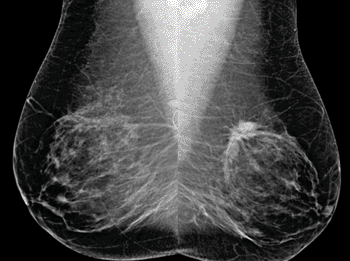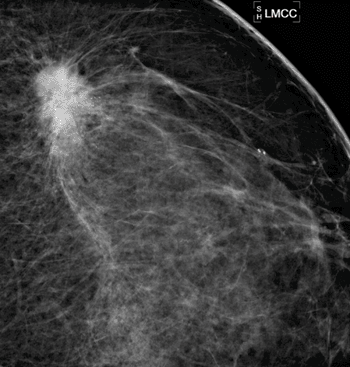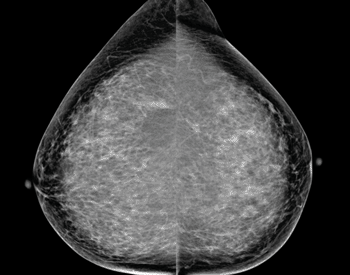Mammography Screening Intervals May Affect Breast Cancer Prognosis
|
By MedImaging International staff writers Posted on 02 Jan 2014 |

Image: Bilateral mediolateral oblique (MLO) views from screening mammography in a 53-year-old woman (Photo courtesy of RSNA).

Image: Spot magnification view demonstrates an irregular spiculated mass with associated calcifications in the upper outer left breast. Ultrasound biopsy revealed invasive ductal carcinoma and DCIS (Photo courtesy of RSNA).

Image: Screening mammogram in a 63-year-old woman demonstrated calcifications in the upper outer left breast. Bilateral craniocaudal (CC) views shown (Photo courtesy of RSNA).
In a study of screening mammography-detected breast tumors, patients who had more frequent screening mammography exams had a considerably lower rate of lymph node positivity as compared to women who had longer intervals between screening-mammography exams.
The study’s findings were presented December 3, 2013, at the annual meeting of the Radiological Society of North America (RSNA), held December 2013 in Chicago (IL, USA). In its earliest stages, breast cancer is confined to the breast and can be treated by surgically removing the cancer cells. Breast cancer cells may metastasize to the lymph nodes as the disease progresses and then to other areas of the body.
“On its pathway to other places in the body, the first place breast cancer typically drains into before metastasizing is the lymph nodes,” said Lilian Wang, MD, assistant professor of radiology at Northwestern University/Feinberg School of Medicine (Chicago, IL, USA). “When breast cancer has spread into the lymph nodes, the patient is often treated both locally and systemically, with either hormone therapy, chemotherapy, trastuzumab, or some combination of these therapies.”
Healthcare organizations, such as RSNA and the American Cancer Society (ACS), have recommended yearly screening with mammography for women beginning at age 40. However, in 2009, the United States Preventive Services Task Force (USPSTF) announced a controversial new recommendation for biennial screening for women between the ages of 50 and 74. “Our study looks at what would happen if the revised guidelines issued by USPSTF were followed by women,” Dr. Wang said.
Conducted at Northwestern Memorial Hospital (Chicago, IL, USA), the retrospective study, included 332 women with breast cancer identified by screening mammography between 2007 and 2010. The women were split into one of three groups, based on the length of time between their screening mammography exams: less than 1.5 years, 1.5 to three years, and more than three years. There were 207, 73, and 52 patients in each category, respectively.
The researchers determined, controlling for age, breast density, high-risk status, and a family history of breast cancer, that women in the less than 1.5-year interval group had the lowest lymph node positivity rate at 8.7%. The rate of lymph node involvement was substantially higher in the 1.5- to three-year and over three-year interval groups at 20.5% and 15.4%, respectively.
“Our study shows that screening mammography performed at an interval of less than 1.5 years reduces the rate of lymph node positivity, thereby improving patient prognosis,” Dr. Wang concluded. “We should be following the guidelines of the American Cancer Society and other organizations, recommending that women undergo annual screening mammography beginning at age 40.”
Related Links:
Northwestern University/Feinberg School of Medicine
The study’s findings were presented December 3, 2013, at the annual meeting of the Radiological Society of North America (RSNA), held December 2013 in Chicago (IL, USA). In its earliest stages, breast cancer is confined to the breast and can be treated by surgically removing the cancer cells. Breast cancer cells may metastasize to the lymph nodes as the disease progresses and then to other areas of the body.
“On its pathway to other places in the body, the first place breast cancer typically drains into before metastasizing is the lymph nodes,” said Lilian Wang, MD, assistant professor of radiology at Northwestern University/Feinberg School of Medicine (Chicago, IL, USA). “When breast cancer has spread into the lymph nodes, the patient is often treated both locally and systemically, with either hormone therapy, chemotherapy, trastuzumab, or some combination of these therapies.”
Healthcare organizations, such as RSNA and the American Cancer Society (ACS), have recommended yearly screening with mammography for women beginning at age 40. However, in 2009, the United States Preventive Services Task Force (USPSTF) announced a controversial new recommendation for biennial screening for women between the ages of 50 and 74. “Our study looks at what would happen if the revised guidelines issued by USPSTF were followed by women,” Dr. Wang said.
Conducted at Northwestern Memorial Hospital (Chicago, IL, USA), the retrospective study, included 332 women with breast cancer identified by screening mammography between 2007 and 2010. The women were split into one of three groups, based on the length of time between their screening mammography exams: less than 1.5 years, 1.5 to three years, and more than three years. There were 207, 73, and 52 patients in each category, respectively.
The researchers determined, controlling for age, breast density, high-risk status, and a family history of breast cancer, that women in the less than 1.5-year interval group had the lowest lymph node positivity rate at 8.7%. The rate of lymph node involvement was substantially higher in the 1.5- to three-year and over three-year interval groups at 20.5% and 15.4%, respectively.
“Our study shows that screening mammography performed at an interval of less than 1.5 years reduces the rate of lymph node positivity, thereby improving patient prognosis,” Dr. Wang concluded. “We should be following the guidelines of the American Cancer Society and other organizations, recommending that women undergo annual screening mammography beginning at age 40.”
Related Links:
Northwestern University/Feinberg School of Medicine
Latest Radiography News
- Novel Breast Imaging System Proves As Effective As Mammography
- AI Assistance Improves Breast-Cancer Screening by Reducing False Positives
- AI Could Boost Clinical Adoption of Chest DDR
- 3D Mammography Almost Halves Breast Cancer Incidence between Two Screening Tests
- AI Model Predicts 5-Year Breast Cancer Risk from Mammograms
- Deep Learning Framework Detects Fractures in X-Ray Images With 99% Accuracy
- Direct AI-Based Medical X-Ray Imaging System a Paradigm-Shift from Conventional DR and CT
- Chest X-Ray AI Solution Automatically Identifies, Categorizes and Highlights Suspicious Areas
- AI Diagnoses Wrist Fractures As Well As Radiologists
- Annual Mammography Beginning At 40 Cuts Breast Cancer Mortality By 42%
- 3D Human GPS Powered By Light Paves Way for Radiation-Free Minimally-Invasive Surgery
- Novel AI Technology to Revolutionize Cancer Detection in Dense Breasts
- AI Solution Provides Radiologists with 'Second Pair' Of Eyes to Detect Breast Cancers
- AI Helps General Radiologists Achieve Specialist-Level Performance in Interpreting Mammograms
- Novel Imaging Technique Could Transform Breast Cancer Detection
- Computer Program Combines AI and Heat-Imaging Technology for Early Breast Cancer Detection
Channels
MRI
view channel
Low-Cost Whole-Body MRI Device Combined with AI Generates High-Quality Results
Magnetic Resonance Imaging (MRI) has significantly transformed healthcare, providing a noninvasive, radiation-free method for detailed imaging. It is especially promising for the future of medical diagnosis... Read more
World's First Whole-Body Ultra-High Field MRI Officially Comes To Market
The world's first whole-body ultra-high field (UHF) MRI has officially come to market, marking a remarkable advancement in diagnostic radiology. United Imaging (Shanghai, China) has secured clearance from the U.... Read moreUltrasound
view channel.jpg)
Diagnostic System Automatically Analyzes TTE Images to Identify Congenital Heart Disease
Congenital heart disease (CHD) is one of the most prevalent congenital anomalies worldwide, presenting substantial health and financial challenges for affected patients. Early detection and treatment of... Read more
Super-Resolution Imaging Technique Could Improve Evaluation of Cardiac Conditions
The heart depends on efficient blood circulation to pump blood throughout the body, delivering oxygen to tissues and removing carbon dioxide and waste. Yet, when heart vessels are damaged, it can disrupt... Read more
First AI-Powered POC Ultrasound Diagnostic Solution Helps Prioritize Cases Based On Severity
Ultrasound scans are essential for identifying and diagnosing various medical conditions, but often, patients must wait weeks or months for results due to a shortage of qualified medical professionals... Read moreNuclear Medicine
view channelNew PET Agent Rapidly and Accurately Visualizes Lesions in Clear Cell Renal Cell Carcinoma Patients
Clear cell renal cell cancer (ccRCC) represents 70-80% of renal cell carcinoma cases. While localized disease can be effectively treated with surgery and ablative therapies, one-third of patients either... Read more
New Imaging Technique Monitors Inflammation Disorders without Radiation Exposure
Imaging inflammation using traditional radiological techniques presents significant challenges, including radiation exposure, poor image quality, high costs, and invasive procedures. Now, new contrast... Read more
New SPECT/CT Technique Could Change Imaging Practices and Increase Patient Access
The development of lead-212 (212Pb)-PSMA–based targeted alpha therapy (TAT) is garnering significant interest in treating patients with metastatic castration-resistant prostate cancer. The imaging of 212Pb,... Read moreGeneral/Advanced Imaging
view channelBone Density Test Uses Existing CT Images to Predict Fractures
Osteoporotic fractures are not only devastating and deadly, especially hip fractures, but also impose significant costs. They rank among the top chronic diseases in terms of disability-adjusted life years... Read more
AI Predicts Cardiac Risk and Mortality from Routine Chest CT Scans
Heart disease remains the leading cause of death and is largely preventable, yet many individuals are unaware of their risk until it becomes severe. Early detection through screening can reveal heart issues,... Read moreImaging IT
view channel
New Google Cloud Medical Imaging Suite Makes Imaging Healthcare Data More Accessible
Medical imaging is a critical tool used to diagnose patients, and there are billions of medical images scanned globally each year. Imaging data accounts for about 90% of all healthcare data1 and, until... Read more
Global AI in Medical Diagnostics Market to Be Driven by Demand for Image Recognition in Radiology
The global artificial intelligence (AI) in medical diagnostics market is expanding with early disease detection being one of its key applications and image recognition becoming a compelling consumer proposition... Read moreIndustry News
view channel
Hologic Acquires UK-Based Breast Surgical Guidance Company Endomagnetics Ltd.
Hologic, Inc. (Marlborough, MA, USA) has entered into a definitive agreement to acquire Endomagnetics Ltd. (Cambridge, UK), a privately held developer of breast cancer surgery technologies, for approximately... Read more
Bayer and Google Partner on New AI Product for Radiologists
Medical imaging data comprises around 90% of all healthcare data, and it is a highly complex and rich clinical data modality and serves as a vital tool for diagnosing patients. Each year, billions of medical... Read more



















